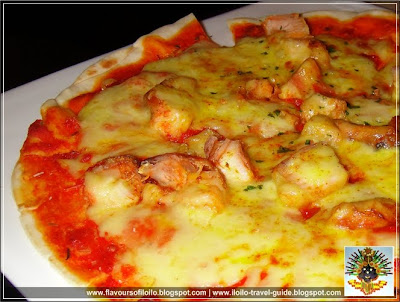
For a restaurant serving a cuisine as “very foreign” as Greek, surviving for a year is already a good sign of acceptance to the discriminating Ilonggos. Serving simple kebabs, walnut Roca and moussaka among others, Terra Mediterranean Cuisine opened its doors at The Avenue, a year ago. And to celebrate its anniversary, a total of 26 new dishes are being introduced adding a new dimension to the restaurant’s already vast menu of Greek-inspired specialties.

Together with some members of the print and broadcast media, I took part in the food tasting session organized by Chef Miner del Mundo held last Wednesday, April 27, 2011. It was a taste of what’s to come as well as enjoying their best sellers.

Up first was, no, this isn’t piaya, but a Greek Tortilla. Grilled thin pita bread filled with tomatoes, mozzarella and seasoned with Greek Spices. It might as well pass as a simple pizza since the filling was rich and savoury, and yes appetizing – I lost count how many I got …

Came next was a sort of ”dips” collection or was it? It was Mezethes (plural for meze) and explained as dishes, hot or cold, spicy or savory, often salty, that is served, alone or with other mezethes, as a separate eating experience. The purpose of the meze is complement and enhance the taste of the drink (for the red wine we had). It came with plain pita and I enjoyed experimenting on it and ended up placing a spoonful of each in the pita bread and devoured.

Then came a fiery order. Nope it didn’t come with a fire dance (but there was one outside) but the Saganaki Cheese order involved fire and really got everybody’s attention in the restaurant that time. Aside from the shouts of from the food servers announcing the special order, a sudden big burst of flame in a subdued ambiance would certainly grabbed everybody's attention and aroused curiosity for such order. Saganaki is the name of a single serve frying pan that is also used also as the serving dish. After being fried, the saganaki cheese is flambéed at the table (typically with a shout of "opa!"), and the flames then extinguished with a squeeze of fresh lemon juice. This is called "flaming saganaki" (from WikiPedia)

Something cold was next and it was a refreshing one – Watermelon and Feta Salad. A mesclun salad with mint and (almost) chilled slices of watermelon sprinkled with feta cheese and “dressed” in red wine vinaigrette. It lightened up the (heavy) appetizers galore with its invigorating mix; aside from the fact, the watermelon was already good on its own.

Then came two Italian specialties heavy with Greek infusion – Grilled Chicken Pizza and Baked Spirali. Made with classic pita bread with Greek tomato sauce, parmesan and mozzarella - it was a delight to enjoy big chunks of meat (chicken in this case) on a pizza when usually it’s just thin slices of it.
The spirals pasta has a savoury meat sauce, herbed béchamel sauce and mozzarella all making a subdued combination of flavours - all complementing none overwhelming.

A Greek Gyros sample made its way to our table. Its very much like a shawarma but it was served on a stick looking more like a barbecue. It was so enticing and tasted good (didn’t use the spicy yoghurt ) that I forgot to take a snapshot of it –lol.

An out-of-the-food-tasting-menu item – Fish Picatta, lengthened the session but it was well worth it. Made with perfectly fried dream dory - still having a crunch despite being having tzatsiki (a sauce/dip made of strained yoghurt (usually from sheep or goat milk) mixed with cucumbers, garlic, salt, usually olive oil, pepper, dill, sometimes lemon juice and parsley, and sometimes mint added) and a bell pepper smear. The lemon added zest to balance the flavours.

Making the finale were desserts and usually it’s among my most awaited part of these kinds of sessions – lol. First was Molten Chocolate Cake – I’ve tasted almost the same but went with the name Molten Lava. Served ala mode (that is with ice cream), the rich chocolate cake was soft, creamy and easily melts in the mouth that I kept on refilling my spoon. But it was the Mango Crepes that I had most. Fresh and sweet mangoes mixed with almond crème then wrapped and topped with vanilla ice cream then smothered with butterscotch sauce. What more can you ask for but another round please!

It was indeed terrific or should I say Terra-fic as the first modern Greek restaurant in Iloilo City showed its constant quest to bring exciting and new dishes that surely captured our senses. And strives more to give Ilonggos a gastronomic journey through the bounty of the sea infusing age-old Mediterranean classic recipes.
Terra Mediterranean Cuisine creates a culture of eating healthy cuisine that is both sustainable and organic!

Terra Mediterranean Cuisine is located at The Avenue Complex along Glicerio Pison Avenue in Brgy San Rafael, Mandurriao, Iloilo City. For reservations and inquiries, contact (033) 508-8878.
--------------
Watch Chef Miner prepare the Watermelon and Feta salad

